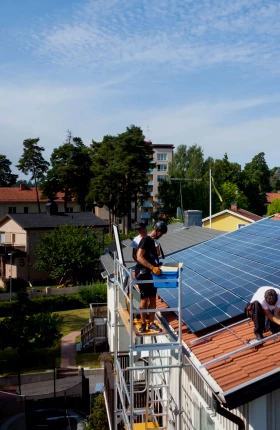Financing is a critical input for achieving the climate goals of the Paris Agreement. Trillions of dollars are needed to decarbonize industries, build renewable energy and other green infrastructure, and support adaptation and resilience projects around the world.
Companies across all sectors of the global financial system have pledged their support. The Glasgow Financial Alliance for Net Zero, launched in 2021 to coordinate companies’ efforts, has more than 550 members, including many of world’s largest banks, insurers, asset managers, and asset owners, such as pension and sovereign wealth funds. All have committed to support the transition to a net zero global economy, and together, they have responsibility for (though not full discretion over) more than $100 trillion in assets. Yet capital flows to green projects are still far too small. A recent study by the Rockefeller Foundation and BCG found that financing needs outweigh current flows by 66%.
Considering the historic shift that these commitments represent, the imbalance is not surprising. These are pledges from large institutions with many stakeholders. Getting even one such organization to begin a major change in how it deploys capital is no small feat. Securing buy-in from so many on an agreement so ambitious is a major achievement—and a critical first step in getting large-scale climate finance up and running.
All financial sectors are now pursuing next steps in figuring out how to apply the general principles of the alliance to a wide variety of activities, including bank lending, insurance underwriting, and stock and bond portfolio management. All sectors must adapt if climate finance is to reach a sufficient scale. But at this crucial juncture, asset owners have an opportunity to make an especially important contribution by increasing the role of private-market investments in their climate strategies.
Driving Real Change
The major private-market asset classes—private equity (PE), venture capital, real estate, and infrastructure—all present near-term opportunities for climate-focused investors. By allocating to climate funds, or by co-investing or directly investing in climate projects, asset owners can advance the net zero transition in several ways. They can drive valuable innovation, spur heavy emitters toward the rewards of decarbonization, and help make blended finance—the combination of private, public, and philanthropic funding and a vital ingredient in the transition—commercially viable. Asset owners can also gain insight into what’s ahead in this large and long transition.
Active management—the signature strength of private-market strategies—is especially useful in climate-focused investing. It gives investors the control they need to drive change as well as the time to accomplish it, without pressure from quarterly earnings cycles. It’s no coincidence that private-market investments have funded much of the global build-out for renewable power and are expected to be an equally big factor in the development of low-carbon hydrogen; carbon capture, usage, and storage technologies; and other advances that will help make infrastructure climate resilient.
Private-market investments already play an important role in the allocations to climate solutions that some asset owners include as part of their climate strategies. Leading asset owners have set ambitious targets. For example, the Canada Pension Plan Investment Board (CPPIB), a major PE and infrastructure investor, aims to increase its holdings of what it calls green and transition assets from $50 billion to $97 billion by 2030.
In addition to helping the planet, asset owners can build valuable expertise by pursuing climate-focused private-market investments. For example, although many investors are researching decarbonization pathways at an industry level, CPPIB is leading the development of a bottom-up framework for assessing the greenhouse gas abatement capacity of individual companies. It is gaining firsthand knowledge of the practical aspects by applying the framework to its own portfolio.
Asset owners can help the planet and build valuable expertise by pursuing climate-focused private-market investments.
Similarly, as blended finance evolves to take on the major climate challenges in the developing world, investors with a seat at the table—such as Temasek and CDPQ, both of which have launched blended finance initiatives—can help shape the definitions and methodologies needed to create standardized, scalable capital structures.
A Strong Interest in Solutions
Amid growing demand for investments that are focused on climate solutions, asset managers are launching more funds. The number of climate-oriented funds launched in the infrastructure, buyout, growth equity, venture capital, and hedge fund categories has grown at a 7% annual rate since 2016, with 113 such funds started in 2022, according to data from the PEI Group and Climate Tech VC. The amount of capital raised for such funds reached $75 billion in 2022, a 29% increase from the prior year.
So far, the number of projects that offer market-rate, risk-adjusted returns has been too small to absorb the amount of capital seeking climate-related investment opportunities. The number of opportunities is likely to expand, however, thanks to growing public-sector support for climate finance. Incentives in the US Inflation Reduction Act of 2022 and the European Union’s Green Deal Industrial Plan are designed to drive investment in carbon capture, utilization, and storage technologies; low-carbon hydrogen production; and various parts of the electric vehicle value chain, including batteries and charging stations. We expect that support for legislative stimulus packages and blended finance vehicles will continue to gain momentum.
The number of investment opportunities is likely to expand, thanks to growing public-sector support for climate finance.
On their own, private-market investments can’t align the majority of the capital controlled by asset owners with net zero goals. Private-market investments account for only about a fifth of the world’s assets under management (AUM) and for a similar share of the typical asset owner’s portfolio, although the proportion is considerably higher for some of the biggest pension plans and sovereign wealth funds. Also, decisions about private-market investments are, of course, fiduciary ones; there are many considerations—including regulations and liquidity needs—aside from climate goals. But for the many asset owners that have private-market investment programs, a formal commitment to invest in climate solutions (alongside a commitment to support blended finance initiatives) can be a powerful component of their climate strategy.
An Action Plan
The six steps below outline an action plan for asset owners looking to up their game in climate-focused private-market investing. The first two steps frame the necessary commitment, and the following four cover execution—which, depending on the organization’s capabilities, may be accomplished via fund investments, co-investments, or even direct investments led by the asset owner. Not all asset owners will be ready for all the steps. The most important thing, however, is to get started and begin amplifying the organization’s impact on climate challenges.
Set a capital deployment target using a segmented view of the climate solutions landscape. Some asset owners aim to allocate at least 10% of their total AUM to various types of climate solutions. They allocate to private-market and other types of investments (often to green bonds) to meet their target. Within the private-market investment portfolios of large asset owners, the proportion of climate-focused investments can approach 20%.
Even a small commitment is worth making. A formal target will signal an interest in these kinds of investments, boosting the number of potential deals reviewed and thereby increasing the asset owner’s knowledge of the market. An official commitment is also a message to stakeholders that a proactive and multifaceted approach to climate finance is in place. Equally important is the higher profile that climate issues will gain inside the organization. The commitment (and the moves needed to implement it) will increase knowledge sharing among asset class specialists and help deepen their consideration of climate factors.
Even a small commitment is worth making. A formal target will signal an interest in these kinds of investments, boosting the number of potential deals.
Planning an allocation requires understanding the risk-return profile of the various investment types, including venture capital, growth equity, transition finance, infrastructure, and real estate funds. Diversified exposure to many facets of the net zero transition—including early-stage innovations, renewable power, and gray-to-green strategies at high-emitting companies—is the goal.
Develop expertise in climate solutions and industries’ decarbonization pathways. Staying current on the ever-evolving net zero transition—and financial sectors’ pivotal roles in it—is too important to outsource. Third-party reports are useful, but asset owners can gain deeper insights by developing proprietary research capabilities. Some of the most attractive investments will be uncovered by understanding the evolving climate policies of governments, the climate targets of corporations and their progress in achieving them, the maturation of climate technologies, and the dynamics of carbon pricing. The insights will be relevant to investment professionals across the organization.
Get ready to tackle a new set of due diligence challenges. Most asset owners prefer established funds over new ones. A lot of comfort—arguably too much—is often taken in a fund’s track record. But in the young world of climate solutions investing, new funds are proliferating, and asset owners would be remiss not to pay attention.
Asset owners would be remiss not to pay attention to the new climate funds that are proliferating.
Some new funds are bringing different kinds of capabilities and expertise to bear on problems that require stepping beyond what’s worked in the past. In earlier-stage investments, for example, too many funds are currently focused on climate software, largely because managing software development in asset-light business models is a sweet spot for traditional venture investing. Meanwhile, some of the most promising climate startups may be comparatively underfunded because they are tackling scientific challenges in asset-heavy sectors, such as battery storage.
Similarly, companies seeking growth capital to build electric vehicle charging networks or flexible electrical grids require much more capital than do companies seeking to finance growth in the health care or consumer products sectors. Asset owners need to learn how to assess these less-familiar factors and the risk-return profiles of the new investments.
Embrace gray-to-green strategies and the need to temporarily add carbon to the portfolio. Private equity investors have begun taking up the challenge of buying companies and adding value by decarbonizing them, a process with some similarities to the many digital transformations they have managed. Both the need and the potential rewards are great.
There are more than a few barriers to overcome, however. Deal teams that are experienced in choosing and managing gray-to-green investments are still in short supply. Hands-on experience matters because teams need more than a high-level view of the decarbonization pathways for the relevant industry. The pathways will continually change as technology and government policies evolve, so investors need to anticipate different pathways and—crucially—the ability of the specific company to adapt. Given these complexities, the holding periods may also need to be longer than those for more traditional PE investments.
Another barrier is the reluctance of many asset owners to temporarily add carbon to their portfolios, even for the sake of making longer-term progress toward global decarbonization goals. Stakeholders that are looking for a steady decrease in carbon exposure may well be skeptical. Asset owners need to explain that the path to net zero is not linear—and that buying high and selling low regarding carbon emissions is a sound strategy both for investors and the planet.
Over time, asset owners can use the insights gained from pursuing gray-to-green strategies to guide their investments in public companies and to engage with them on their decarbonization efforts. The data that asset owners gather can also be used to strengthen their carbon reports and demonstrate to stakeholders that instead of just greening their portfolios through divestitures, they are making a real-world impact by directing capital to the companies leading positive change.
Seek experience in blended finance to be ready to co-invest. Global leaders expect blended finance to play a central role in meeting many of the world’s biggest climate challenges, especially those in emerging markets and developing economies. For blended finance investments to have a risk-return profile suitable for private-market investors, public and philanthropic organizations must assume an additional share of the risks.
Blended finance is not yet happening at anywhere near the necessary scale. A report from Convergence on the state of climate-oriented blended finance notes that flows fell to about $2 billion in 2022, down from $7 billion per year during the prior decade. But several big projects (many pursuing the development of low-carbon hydrogen) were announced in 2022, and global leaders are pushing for development finance institutions to do much more.
So far, most of the private capital in blended finance funds has come from commercial banks that have expertise in lending into complex structures. However, others understand both the need and the opportunity to greatly expand the climate investment landscape. Some asset owners are participating in climate funds such as Climate Investor One and Climate Investor Two, both of which are sponsored by Climate Fund Managers and whose backers include the European Union. Asset owners Temasek and CDPQ are partnering with commercial banks (HSBC and Mitsubishi UFJ Financial Group, respectively) on infrastructure investment programs. And in September 2022, the UN-convened Net-Zero Asset Owner Alliance published recommendations for policymakers on how to scale blended finance.
Asset owners that are able to participate in the development of climate-oriented blended finance investments will benefit as this new category opens up.
While climate-oriented blended finance investments are still too scarce and too bespoke, asset owners that are able to participate in their development will benefit as this important new private-market investment category opens up.
Prepare to provide leadership, expertise, and connections, as well as capital. Capital and technological innovation are typically not sufficient inputs to ensure the success of companies that are developing climate solutions or pursuing decarbonization. These companies are also likely to need assistance with other challenges, such as making business-to-business sales of innovative technologies, connecting with the dispersed network of experts it takes to plot a practical path to net zero—or even rethinking how their business works. For example, to repurpose assets for capturing carbon, a company that operates a midstream gas pipeline will need to change a simple business model that it has relied on for decades.
Lead investors and co-investors must be prepared to increase the level and types of nonfinancial support they can supply. Asset owners should consider companies’ nonfinancial needs when conducting due diligence and develop an understanding of the success factors in climate-focused private-market investments. All parties need to get comfortable with the degree of co-opetition in climate investments and be confident that the companies in their portfolios can take advantage of collaborations, such as the First Movers Coalition (which encourages demand for climate solutions) while still prioritizing the market-level returns that stakeholders need.
Adjusting the Traditional Boundaries
The net zero transition requires change and rethinking on the part of all companies, and asset owners are no exception. Indeed, the efforts to build momentum in climate finance can be seen partly as a process of adapting the traditional boundaries of the majority of asset owners to accommodate a new, more dynamic set of financing needs that—especially at this early stage of climate finance’s development—are best accompanied by active, hands-on management.
It’s no accident that many of the asset owners now leading the way in climate finance are also among the most active in private-market investing, the most innovative, and the most likely to take a holistic view of their portfolios as asset classes evolve. Although the majority of asset owners may not be ready to undertake everything that the biggest, best-resourced pension and sovereign wealth funds are doing, they have a chance to make a bigger impact in climate finance. In doing so, asset owners will also be preparing for their own success as the transition to net zero accelerates—as it surely must.






